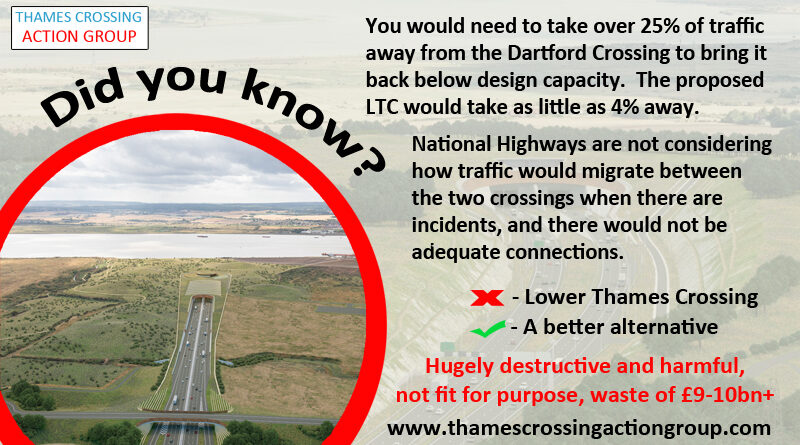LTC – Not fit for purpose
As well as concerns that it would be hugely destructive and harmful, one of the other main reasons that we and so many others strongly oppose the proposed Lower Thames Crossing is because it is simply not fit for purpose.
What is the purpose of the proposed Lower Thames Crossing?
The original decision for a new crossing was due to all the congestion and pollution issues at and around the Dartford Crossing, and that is what National Highways (NH) were tasked to design a new crossing for, to fix those problems.
Jump forward to present day and the list of ‘benefits of the proposed LTC has morphed into being about economic benefit and growth. Yet whilst NH keep talking about the economic benefits of the LTC, they refuse to provide an estimated figure on what those economic benefits would be. If they are as good as they like to suggest, then surely they’d be shouting the figure from the rooftops, not refusing to share it!
How much over capacity is the Dartford Crossing?
- The Dartford Crossing was designed to take 135,000 vehicles per day, but often now sees 180,000 vehicles per day using it.
- This means that you would need to take more than 25% of traffic away for it to be back under the design capacity.
So would the proposed LTC fix the problems at the Dartford Crossing?
In the 2018 NH predicted LTC would take 22% of traffic away from the Dartford Crossing.
On numerous occasions, before he resigned unexpectedly in July 2019, LTC Project Director, Tim Jones had publicly stated that the LTC would not solve all the problems we all suffer with due to the Dartford Crossing.
More recently on 2nd Sept 2021 in a BBC Essex Radio interview LTC Project Director, Matt Palmer also admitted that the LTC would not solve the problems.
In the 2021 NH now predicted that the LTC would take 21% of traffic away from the Dartford Crossing in its opening year, and that would drop down to just 14% by 2044.
In the 2022 NH said the LTC would take around 20% of traffic away from the Dartford Crossing.
In the 2022/23 DCO application NH states that the LTC would take around 19% of traffic away from the Dartford Crossing, in the opening year, dropping to 13% by 2045.
However, Thurrock Council, who have been provided with traffic modelling data by National Highways, have reached the conclusion that the proposed Lower Thames Crossing (LTC) would take as little as 4% of traffic away from the Dartford Crossing. They have also concluded that the Dartford Crossing would be back to todays level of traffic within 5 years of the LTC opening, if it goes ahead.
It is also predicted there would be around a 50% increase in cross river traffic if the proposed LTC goes ahead.
It is also worth noting that in LTC DCO documentation (page 181 – PDF page numbering), at A.1.4 it says “The Lower Thames Area Model (LTAM) traffic model is based on 2015 trip patterns“, which is ludicrous. They are using traffic modelling based on data that is over 8 years old.
So as you can see the answer to the question of whether the proposed LTC would solve the problems due to the Dartford Crossing the answer is NO!
What would happen when there’s an incident at the Dartford Crossing or LTC?
Currently there are over 3000 incidents at the Dartford Crossing per year, which as we all know often sees long delays and disruption throughout the region.
National Highways do not have to and are not considering how traffic would migrate between the two crossings when there are incidents, if the LTC goes ahead, and there would not be adequate connections.
The highlights are that there would be just one single lane from the A2 coast bound onto the LTC to the south of the river. To the north there would be no access to the LTC from the A13 east bound, and there would be 5 lanes on the M25 going on to just 2 lanes south bound on the LTC until past the A13.
Take a look at our Incidents update that gives more detail into why the lack of adequate connections would lead to more chaos, congestion and pollution.
TCAG Conclusion
It has been apparent to us for years now that the Dartford Crossing would still be over capacity even if the LTC goes ahead. Not only would the proposed LTC be hugely destructive and harmful, it would not solve the congestion and pollution issues at the current crossing. National Highways have even admitted in public that it would not solve the problems.
National Highways also claim that the new crossing would bring economic benefits, yet they refuse to share an estimated figure for the economic benefits.
Not only that, National Highways are not considering or planning how traffic would migrate between the two crossings when there are incidents, if the LTC goes ahead, and there would not be adequate connections. The result would be more chaos, congestion and pollution.
With the cost now up to £9-10bn+, the proposed LTC is simply not fit for purpose, and certainly cannot be considered good value for taxpayers’ money.
Related
Transport Xtra (May 2022) – click here
New Civil Engineer (June 2022) – click here

